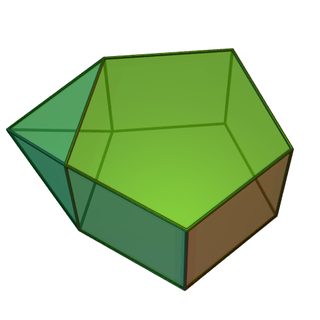Top Qs
Timeline
Chat
Perspective
Augmented pentagonal prism
52nd Johnson solid From Wikipedia, the free encyclopedia
Remove ads
In geometry, the augmented pentagonal prism is a polyhedron that can be constructed by attaching an equilateral square pyramid onto the square face of pentagonal prism. It is an example of Johnson solid.
Remove ads
Construction
The augmented pentagonal prism can be constructed from a pentagonal prism by attaching an equilateral square pyramid to one of its square faces, a process known as augmentation.[1] This square pyramid covers the square face of the prism, so the resulting polyhedron has four equilateral triangles, four squares, and two regular pentagons as its faces.[2] A convex polyhedron in which all faces are regular is Johnson solid, and the augmented pentagonal prism is among them, enumerated as 52nd Johnson solid .[3]
Remove ads
Properties
Summarize
Perspective
An augmented pentagonal prism with edge length has a surface area, calculated by adding the area of four equilateral triangles, four squares, and two regular pentagons:[2] Its volume can be obtained by slicing it into a regular pentagonal prism and an equilateral square pyramid, and adding their volume subsequently:[2]
The dihedral angle of an augmented pentagonal prism can be calculated by adding the dihedral angle of an equilateral square pyramid and the regular pentagonal prism:[4]
- the dihedral angle of an augmented pentagonal prism between two adjacent triangular faces is that of an equilateral square pyramid between two adjacent triangular faces, ,
- the dihedral angle of an augmented pentagonal prism between two adjacent square faces is the internal angle of a regular pentagon .
- the dihedral angle of an augmented pentagonal prism between square-to-pentagon is that of a regular pentagonal prism between its base and its lateral faces .
- the dihedral angle of an augmented pentagonal prism between pentagon-to-triangle is , for which adding the dihedral angle of an equilateral square pyramid between its base and its lateral face , and the dihedral angle of a regular pentagonal prism between its base and its lateral face.
- the dihedral angle of an augmented pentagonal prism between square-to-triangle is , for which adding the dihedral angle of an equilateral square pyramid between its base and its lateral face, and the dihedral angle of a regular pentagonal prism between two adjacent squares.
Remove ads
References
External links
Wikiwand - on
Seamless Wikipedia browsing. On steroids.
Remove ads












